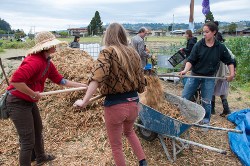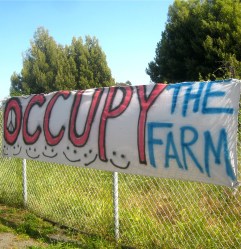
Photo by Steve Rhodes.
“Maybe you’ll be my one phone call from jail,” urban farmer and activist Ashoka Finley says, just before our phone conversation ends.
He’s joking, but I imagine he can probably see a group of police officers out of the corner of his eyes as he says it. Finley is one of a group of Occupiers who have been living and farming on a 10-acre piece of land on the outskirts of Berkeley, Calif., called the Gill Tract.
Finley has also just told me that he’s prepared to get arrested if things at the Gill Tract escalate. “We’re not going anywhere, we’re going to keep planting and farming,” he says, as if it’s the most defiant thing he can imagine.
Until recently, the Gill Tract was a fairly invisible piece of property many Bay Area residents have driven by for years: Its fence butts right up against a major freeway intersection en route to the San Francisco Bay Bridge. Then, on Earth Day, April 22, Finley and fellow activists cut a bolt, set up tents, and began planting food. Their occupation has transformed the Gill Tract into a kind of stage on which a very modern drama is playing out.
Since we first reported on the Gill Tract occupation last week here on Grist, things on the ground there have begun heating up.
On Wednesday, the day I spoke with Finley, the land’s owners, University of California at Berkeley, had officially lost their patience. The college had sent in campus police officers to blockade the entrances to the property in what appeared to be a slow-and-steady tactic similar to their approach to a student-led tree sit that took place at UC Berkeley a few years back. Later in the afternoon, UC announced its intent to take legal action against 14 of the group’s organizers for trespassing and illegal encampment, among a list of other grievances.
UC cut off the water supply to the property shortly after the occupation began, and Finley says they have been trucking in water ever since. Once vehicles could no longer enter the property on Wednesday, the Occupiers parked at the edge of the plot and set up “a water train” of people passing buckets. “Watering three acres by hand is no small task,” he says.
In the last week, university officials have met with the Gill Tract Occupiers, and in the days since then the university issued an ultimatum. Then the Occupiers responded with a list of their own demands.

Both parties want decision-making power over the land. The Occupiers want to see it farmed in perpetuity as a sustainability-focused education center, while the university sees the tract primarily as an agricultural laboratory. It also has plans to redevelop buildings at the edge of the property into retail space, including, ironically, a Whole Foods Market.
In the short term, the farmers want access to water, and the university says it will grant that access only after the tents have been removed.
“We’ve been really patient. This occupation has been going on since April 22 and we’ve taken no direct action until today,” said University of California spokesperson Dan Mogulof on Wednesday afternoon. “The last thing we want is confrontation.”
That makes sense, of course. University officials know that the eyes of the media are on the Gill Tract. And not much time has passed since the 10-campus university system was criticized for its response to Occupy protests last fall (including at UC Davis, where the famous pepper-spray incident went down). In fact, just last week, UC released a draft of a report that urges restraint and mediation in cases of civil disobedience.
But Mogulof prefers to frame the discussion as one about the core principles of academia. “We cannot negotiate academic freedom,” he said, referring to the research that takes place at Gill Tract. “It’s the heart of what every great research institution is all about — the ability of our faculty and students to pursue their intellectual and academic interests in a free and unfettered fashion without interference from the administration, corporations, politicians, or government. And certainly not from a self-selecting group of individuals.”
It’s odd to hear the word “corporations” on this list of unwanted external influences, since UC Berkeley has been heavily criticized for its corporate relationships, including a recent collaboration with BP and a five-year research deal between plant biologists and the biotech company Novartis. There are no genetically engineered crops grown on the property. But many of the protesters have pointed out the sharp contrast between the typical Gill Tract tableau of the past and the new scene there today: Instead of the uniform rows of industrial corn that have grown here every summer for the last several decades (thanks to research funded in part by the nearby Western Regional Office of the United States Department of Agriculture), Occupy has brought a multigenerational crowd to the location, looking excited and sun-kissed as they work together to build a farm.
Not that all Gill Tract’s neighbors support the occupation. In fact, several see it as a brash and aggressive approach by outsiders to grab something many of them had been working to get for a long time — access to the Gill Tract. (In this recent op-ed, a nearby citizen refers to the four-year negotiation he and other neighbors participated in with the area city council.)
Of course, as UC sees it, getting the Occupiers off the land is the first step to a negotiation process that could, they say, involve some inclusion of urban farming on the plot — at the university’s discretion.
“There is room on the site for both our research and for urban farming. It’s possible that some or all of what [the Occupiers] have planted could remain. But that’s far from certain,” says Mogulof.
The Occupiers see it in reverse; rather than a research facility with some space for actual farming, they envision a farm with some space for research. In fact, one agroecological researcher who grows experimental crops in the Gill Tract tried to begin his research for the season on Wednesday morning. Miguel Altieri appeared at the plot in an effort to plant dry-farmed tomatoes, but was reportedly told by university police that he wasn’t authorized to do so [hear a short audio interview with Altieri]. Apparently, he then passed the tomatoes through the fence and instructed the Occupiers how to plant them.
“Obviously research can continue under the context of this organic farm,” says Finley. “But the UC administration has forbidden all research — just as a political move. If researchers started cooperating with us, it would send a message that it can continue without their supervision.”
It’s clear, however, that the right to do research is only part of the issue for UC. One recent university statement read, “If the encampment is ended we are, as previously stated, more than willing to discuss opportunities for a metropolitan agriculture program affiliated with the campus.” Either way, says Mogulof, “We think it’s clear that there’s shared interest if they’re willing to take the simple step of allowing the rightful owners to regain the supervision and control of the land.”
Then again, the Occupy movement has always been about giving a voice, however fleeting, to disenfranchised young Americans who feel they have very little to lose. Ownership might not be a sacred concept, or even a major priority, for many of the younger Occupiers. They graduated at a time when the relationship between student debt and the availability of work for people under 25 might lead them to doubt they will ever be able to own a car, let alone a piece of land. Meanwhile most young people who do dream of farming probably know they’re likely to have to rent land for the foreseeable future.
Former UC agroecology student Anya Kamenskaya, an Occupy the Farm organizer who is named in the UC lawsuit, told me that the Gill Tract started as a 104 acres of prime agricultural land — the kind with soil that can grow food without needing much preparation (scientists call it “class 1”). As she described it to me, I started thinking about how many houses, streets, businesses, and gas stations has been built right over this soil.
“There are only 10 acres left, and only about five are really presently useful for farming,” she said. “We want to highlight the fact that it started out as farmland and it’s been parceled out and cut down.”
That’s why, on Wednesday night, the Occupiers were gathering at a nearby community center, marching to the farm, and preparing — if necessary — to get arrested for those five acres of good remaining soil.
Update: On Thursday afternoon there had still been no arrests, but the #occupythefarm Twitter feed reported that UC police has stopped allowing anyone to enter or exit the Gill Tract. The farmers tweeted “asking for sandwiches, prepared food, nuts, power bars, dried fruit, things that are easy to get over a fence.”
Watch an Occupy the Farm solidarity march from Wednesday, May 9:



